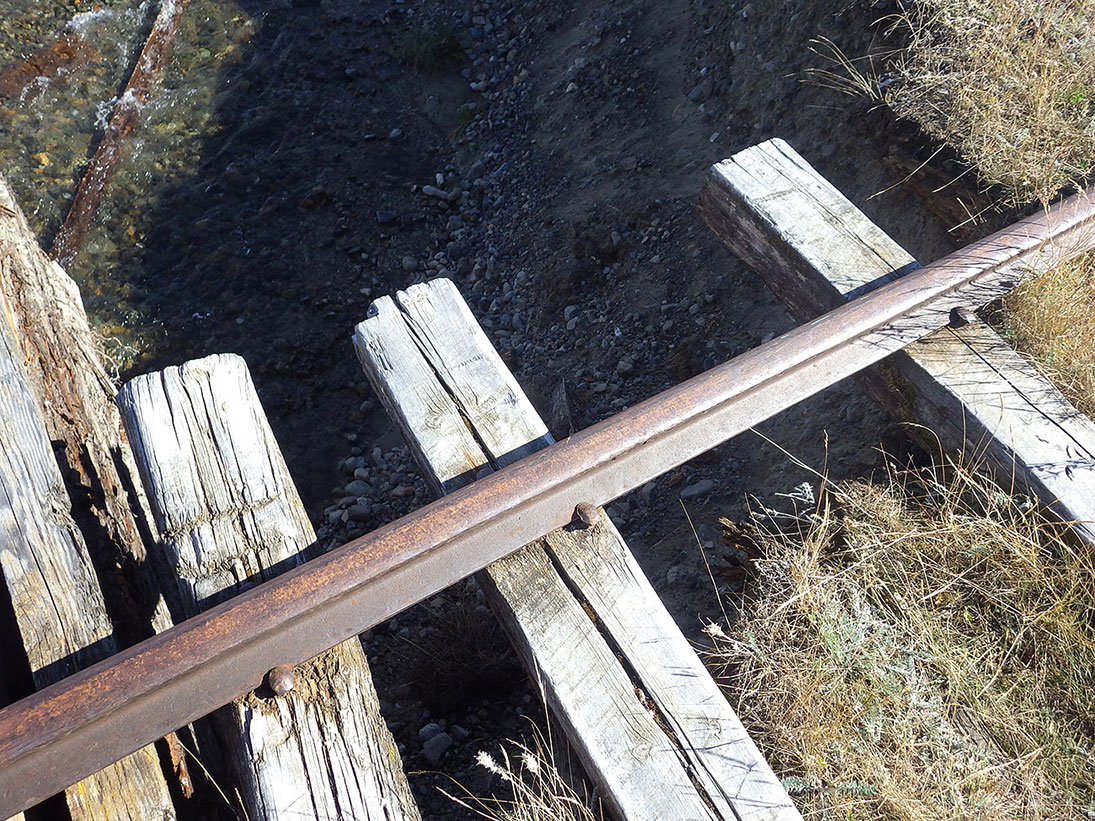
Photo by Photo Submitted
ENDLESS WASHOUTS – This is one of many washouts between Carcross and Whitehorse. Photo by TIM GREEN

Photo by Photo Submitted
ENDLESS WASHOUTS – This is one of many washouts between Carcross and Whitehorse. Photo by TIM GREEN
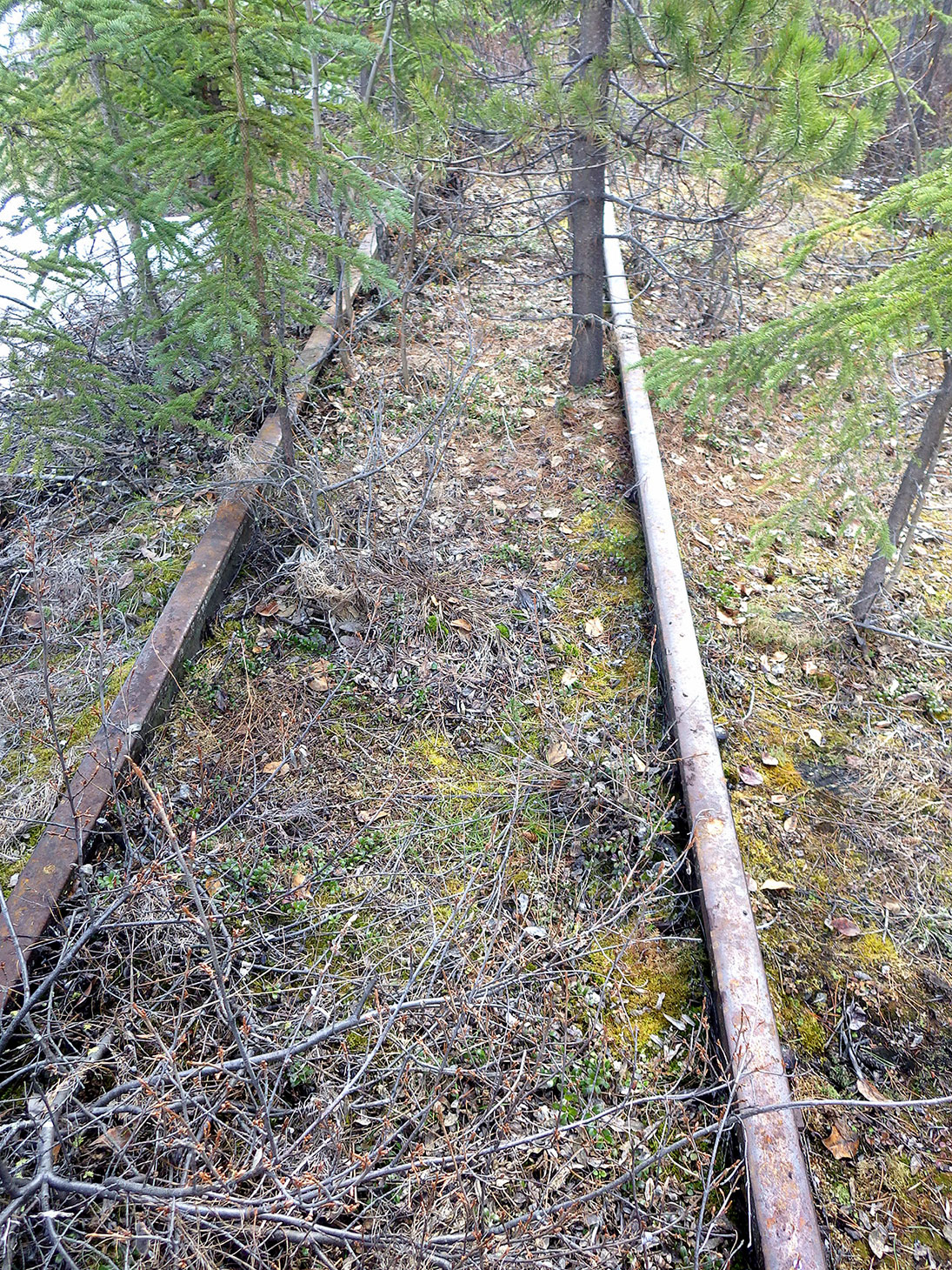
Photo by Photo Submitted
A SERIOUS OBSTACLE – A significant tree is growing up between the rails near Mary Lake. Photo by TIM GREEN
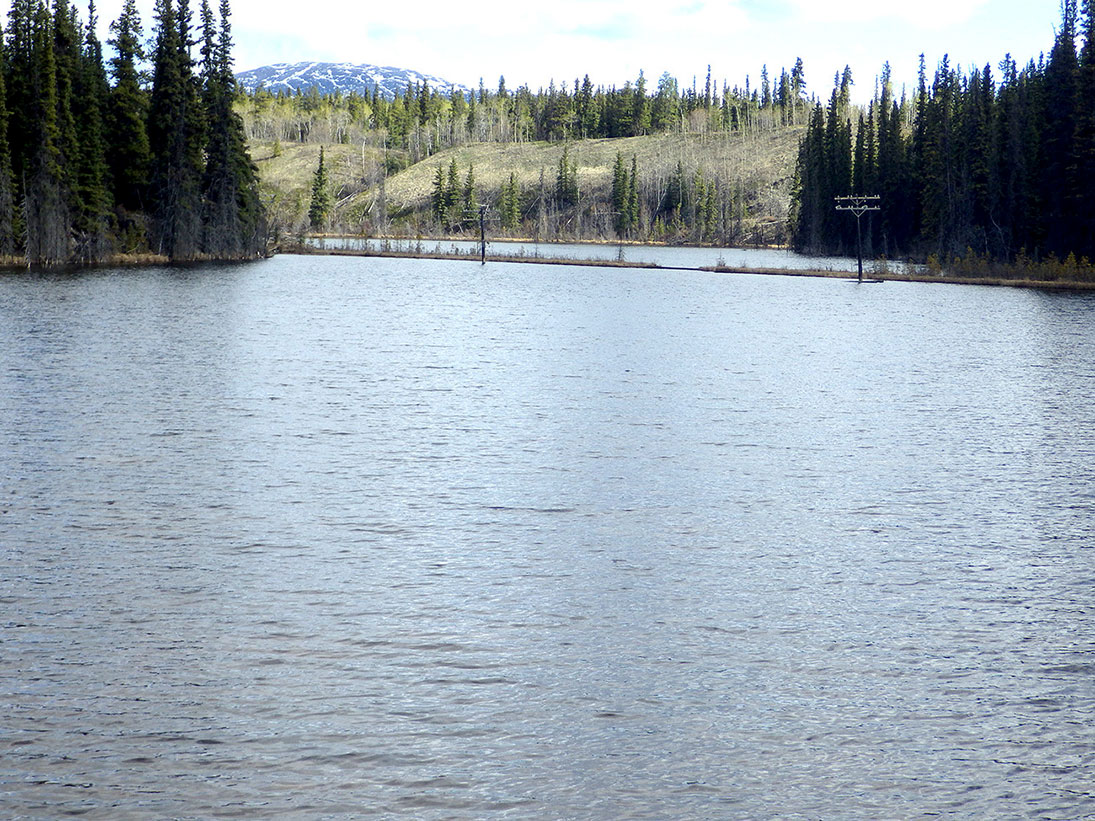
Photo by Photo Submitted
WASHOUT WOES – The White Pass and Yukon Route crossing at Mary Lake. The centre of the causeway is washed out. Photo by TIM GREEN
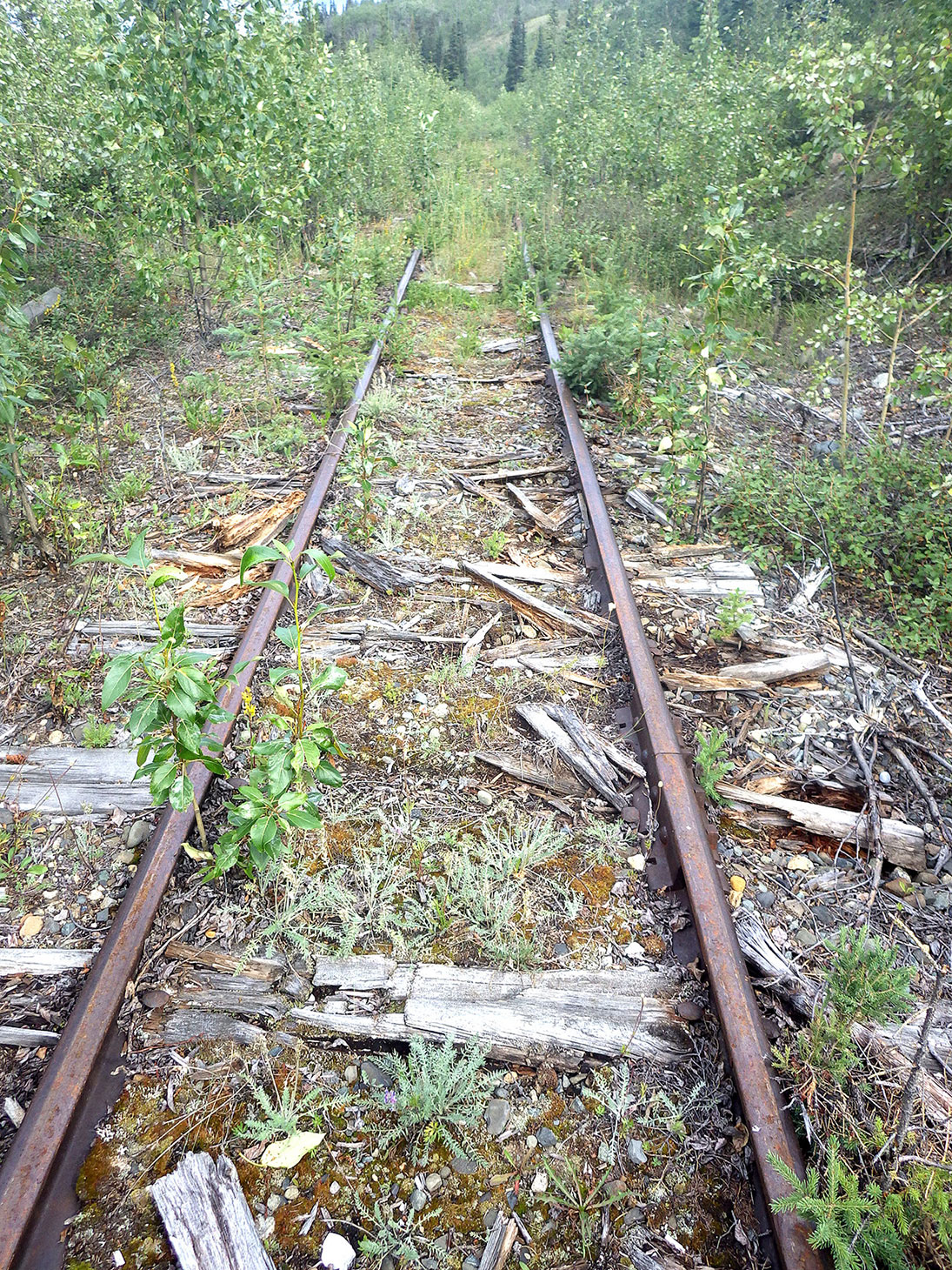
Photo by Photo Submitted
VANISHING TIES – Disintegrating ties in one of the clearer, better-preserved sections of track near Lewes Lake. Photo by TIM GREEN
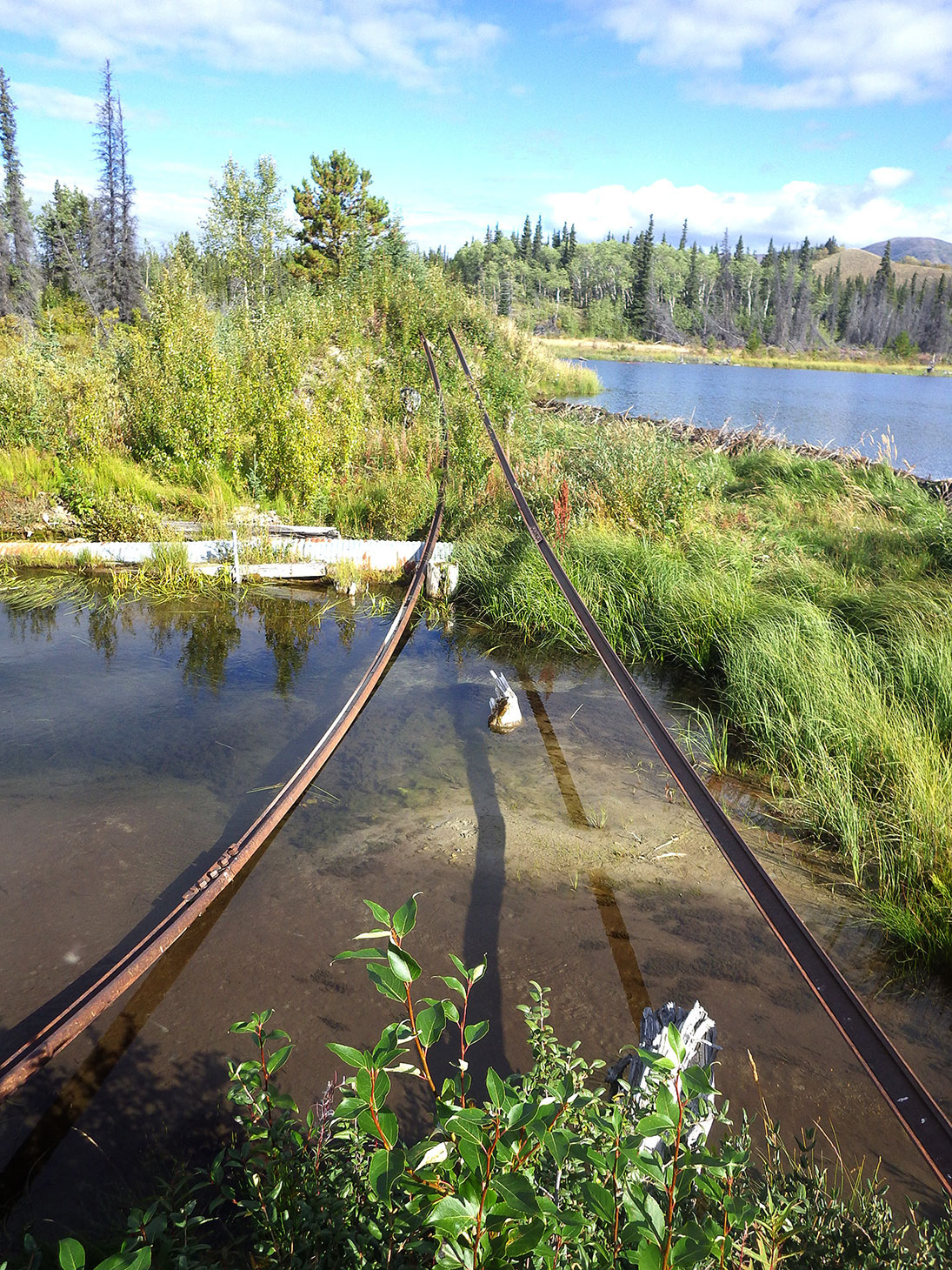
Photo by Photo Submitted
BIG-TIME WORK NEEDED – This major washout would require significant rebuilding. Photo by TIM GREEN
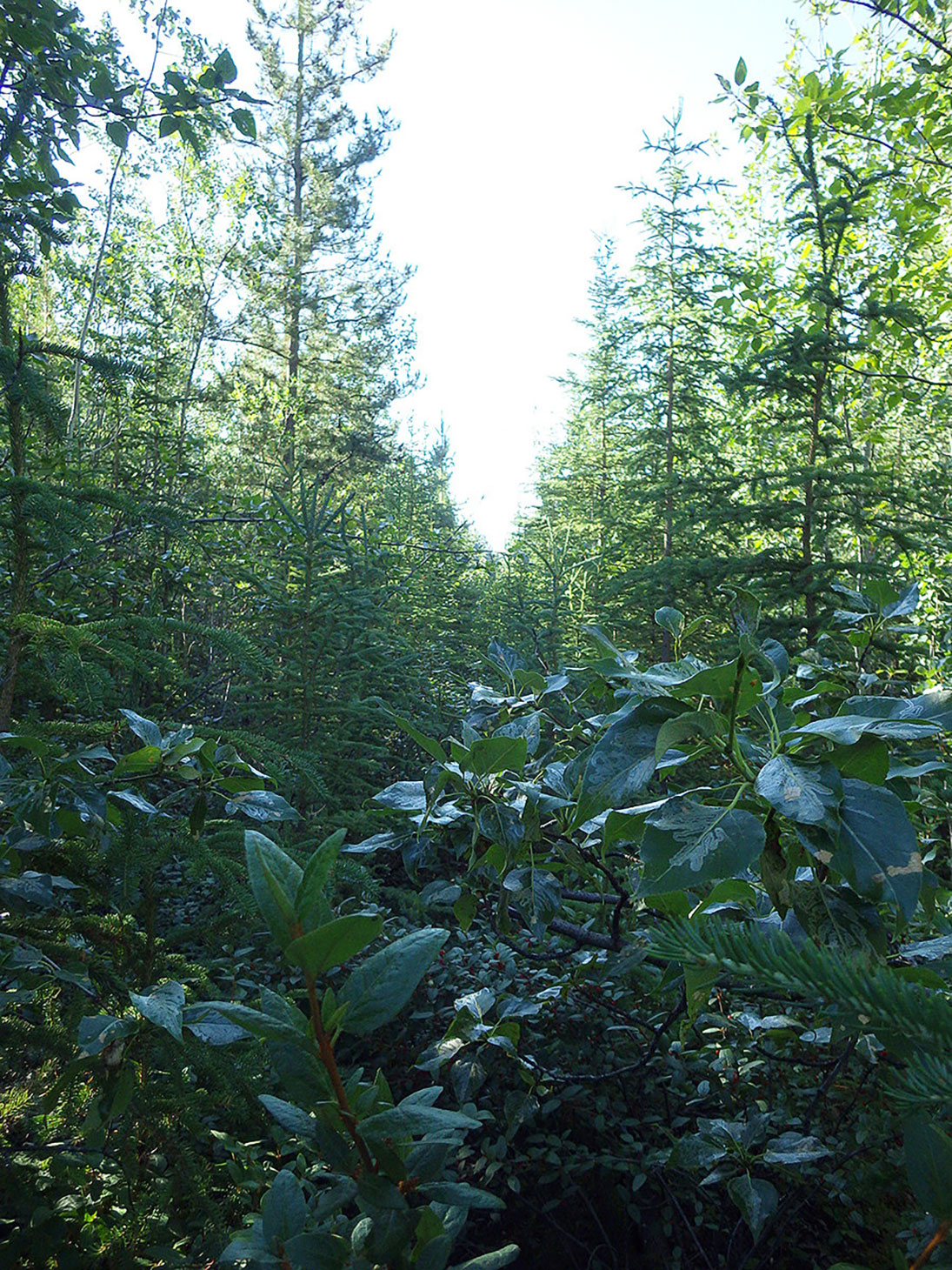
Photo by Photo Submitted
DENSE FOLIAGE – Looking south along the White Pass and Yukon Route near Whitehorse. Photo by TIM GREEN
The White Pass and Yukon Route (WPYR) railway started service between Skagway and Whitehorse in 1900.
The White Pass and Yukon Route (WPYR) railway started service between Skagway and Whitehorse in 1900.
Even though summer tourist passenger service still takes place between Carcross and Skagway, the track between Carcross and Whitehorse has not seen a revenue train since 1982.
Any discussion of the WPYR’s future generally elicits comments from people believing that restoration of train service to Whitehorse is only a matter of time, and that it could come quite quickly.
After all, the track is still there! White Pass, currently owned by Klondike Holdings LLC, did not tear it up. Therefore, they must be planning to restore service any day now.
Unfortunately, optimism does not trump reality. And the reality of the situation is that Whitehorse will probably never see WPYR train service again, certainly not in the short to medium term anyway. Let’s look at the reasons.
The 69 kilometres (43 miles) of track north of Carcross has had no significant maintenance in more than 40 years. Nature’s ruthless attack on unmaintained infrastructure is interesting to observe.
The 19-km (12-mile) section from Yukon Energy to south of Mary Lake is heavily overgrown. Along Mary Lake especially, significant trees are growing right in the middle of the track.
In many other parts of this section, walking the right-of-way is difficult, and finding the rails is a challenge even if one knows where to look.
Running the first train would require a lot more than simply brushing out a few evergreens and selling them off as Christmas trees, as some have suggested.
South from Robinson along Lewes Lake and farther, the right-of-way is generally much clearer, possibly as a result of a brushing program that took place for unknown reasons in the last 10 years.
But even there, no train could operate, although the rails are fairly clear.
The wooden ties are rotten and crumbling. In many places, spikes have popped out, and the rail is loose. The first train over this section would turn the rails and quickly grind to a halt on the ground.
The track crosses Mary Lake and two lobes of Cowley Lake on causeways. Changing water levels in the last 40 years mean that these causeways are now wet right up to the rail in most places, and the rail is simply hanging over open water in others.
So, in these areas, no solid base exists to support the weight of any train passing over them.
Washouts have occurred in at least five locations, taking out bridges and significant portions of the roadbed, again probably due to changing water levels.
Restoring the track in these areas would be the relatively easier part.
The much harder task would be making changes farther afield to ensure new drainage patterns, and levels would not quickly wash the track out again.
The clay cliffs parallel to Whitehorse’s Robert Service Way were always somewhat problematic for operation of the railway that ran between the road and the cliffs.
Forty years of clay erosion and the 2022 landslide in this area would require a major clearing effort to start, and then some new ideas to keep operations safe.
Optimists imagine happy tourists and cheerful Yukoners boarding the train at the Whitehorse station on Front Street.
But the waterfront area has evolved significantly since the last train pulled out.
Before the next train pulls in, the WPYR would need some way of turning locomotives in Whitehorse.
If not a wye like at Carcross or Bennett, or a balloon track like at Fraser, then at least Whitehorse would need a runaround: a section of track parallel to the main where the locomotives that led the northbound train into the station could “run around” the train to lead it south again.
There is little place to put this, maybe none at all, given the current configuration of the waterfront area with the wharf, the relocated and inappropriately named Roundhouse, the Kwanlin Dun Cultural Centre, Shipyards and other development.
The picture is a bit brighter if one assumes freight-only traffic operating out of Utah Yard near the corner of the highway and Mount Sima Road. That area, which is well away from downtown Whitehorse, has ample room for a runaround.
How much?
So, the track between Carcross and Whitehorse needs more than just a bit of fix-up. It requires a complete rebuild and, in some cases, re-design. How much would that cost?
Assume that a rebuild could avoid the requirement for new rail by using the existing old steel. Ignore infrastructure issues in Whitehorse.
A rebuild would still require
about 129,000 ties, several new brid-ges, significant construction in wet-lands, consultations and approvals, plus engineering.
Railways outside Yukon have techniques and machinery to pick up and lay down track fast, but it is all designed for standard gauge (1,435 mm, 56.5 inches), not the narrow gauge (914 mm, 36 inches) of the WPYR track. So the rebuild would require a lot of manual work.
Even under the best conditions, railways don’t come cheap. A conserva-tive estimate to rebuild the WPYR between Carcross and Whitehorse is $1.25 million/km ($2 million/mile) or about $86 million to start.
Before anyone would put money into rebuilding the track, they would want some reassurance of payback in a reasonable time. So how would this new track generate money?
White Pass turns a profit in non-COVID years on rail tours for Skagway cruise ship passengers and tourists.
Scenery over the pass and along Bennett Lake to Carcross is superb, and the trip lengths fit in nicely with cruise ship schedules and buses.
That success would not automatically translate well into extensions of several hours to take passengers to Whitehorse across terrain that is less dramatic.
Certainly, some tourists would make the trip but never enough to make this part of the line profitable on its own.
Mining companies have expressed interest in using the WPYR to transport ore to Skagway. White Pass rebuffed recent proposals to do this.
But who knows? Maybe the new owners since 2018 would be more open to the idea of freight in addition to passengers.
A lucrative long-term freight contract would be the only thing that might stimulate any realistic interest in investing what is required to restore rail service to Whitehorse.
No mines seem to be clamouring for this at the moment, however.
A further complication that might add to the cost is the uncertainty surrounding the Skagway ore dock, which does not belong to White Pass.
Furthermore, the start of freight operations would require a fleet of appropriate freight cars and probably more locomotives, which would increase the capital cost.
Asset or liability?
An unused railway South of 60 can be an asset. The owner sells the whole thing to a salvage company, which picks up all the ties and rails for resale, then sells off the land to adjacent landowners.
Is that a viable fate for the WPYR?
None of the ties here are suitable for resale.
The resale value of the steel for scrap is uncertain, given the distance to market and the transportation costs from Yukon.
We already have lots of scrap steel here in Yukon that does not get shipped Outside because transportation costs exceed sale revenue.
Railway salvage companies have clever equipment for picking up track efficiently but it too is designed for standard gauge. So, the recovery process would be expensive, with no assured payback.
White Pass owns the right-of-way land, which, for most of the 69 km between Whitehorse and Carcross, is a corridor 30 m wide.
There are no adjacent landowners along much of that route so resale is probably not a potential source of significant revenue.
Perhaps the WPYR, as it is in situ, is a liability, not an asset. If recovery or salvage of the track is not cost-effective, what is the effect of just leaving it there for another 40 years?
One concern is the chemicals in the wooden railway ties, many of which are currently immersed in water.
Others cannot be recovered due to their crumbling nature.
In her 1997 “Carcross Waterfront Research Project” https://emrlibrary.gov.yk.ca/justice/carcross-waterfront-research- project-1997.pdf, Helene Dobrowolsky describes how WPYR ties were treated in a tie plant in Carcross using a hot-and-cold bath with a mixture of diesel fuel and pentachlorophenol (PCP).
PCP is toxic, has low mobility in soil, and is slightly soluble in water where it accumulates in sediments https://pubchem.ncbi.nlm.nih.gov/compound/Pentachlorophenol.
Is that a problem in the Yukon context? We probably need some study here.
But given that nobody seems to be worried about the environmental effect of 129,000 PCP-treated wooden ties spread over 69 km of Yukon and the steel rails are fairly innocuous, then maybe the WPYR track north of Carcross is neither an asset nor a liability.
Perhaps that’s why White Pass has done nothing with it for 40 years; doing anything would cost more than it is worth whereas doing nothing costs nothing, or at least relatively little.
Of course, the spectre of climate change haunts everything these days.
The increase in the water level of McConnell Lake west of the Mount Lorne Community Centre over the last 10 to 15 years may or may not be due to climate change.
Regardless, landowners in the area are very conscious of the flow of excess water east and north toward Cowley Lake through a wide channel bisected by the WPYR embankment.
The flooding of private property has convinced some owners that the embankment is to blame.
So maybe the WPYR is somewhat of a liability if it is now causing problems due to changes in our environment over the last 120 years.
One idea that crops up every so often is to turn the WPYR right-of-way north of Carcross into a multi-use trail.
That would mean hikers coming over the Chilkoot Pass could take the train from Bennett to Carcross and then continue hiking to Whitehorse on the new trail for the full Yukon experience.
And mountain bikers arriving in Whitehorse could pedal the new trail to Montana Mountain to experience the world-class cycling there.
Active-lifestyle Yukoners and tourists in Whitehorse could hike or cycle shorter or longer sections of the trail as they saw fit, with drop-offs or pickups at various points along the highway.
Yukon could use the new trail as a development opportunity like the CTFN’s Singletrack to Success project. The trail could also be the centre of some economic development potential.
But establishing such a trail would require the co-operation of White Pass to sell, lease, or lend the right-of-way. The company has given no indication they are interested in this.
So why does White Pass hang onto the WPYR right-of-way north of Carcross? Many have asked that question.
I asked that question to White Pass and ended up speaking with Tyler Rose, their executive director of strategic planning.
White Pass considers the line north of Carcross to be a long-term asset, kept for the day when it can be put back into operation as a freight railway for mines in Yukon.
Once freight is running, passengers could follow. But no, there are no immediate plans for this; no serious mining customers knocking at the door.
White Pass recognizes that resuming operations would require a complete rebuild, less than $100 million by their estimate.
And they are not interested in turning it into a multi-use trail, even temporarily, because once that happened, they could probably never get it back if they wanted to run trains again.
Is White Pass being realistic?
Shortline railways South of 60 have shown that under the right conditions, they can generate sufficient profits to cover their operating costs, including ongoing maintenance.
But also paying back the capital costs of significant new rail construction or major reconstruction of existing rail out of operating revenue is not feasible unless at least one of the following conditions applies.
The first is government subsidies. A government might decide to make a major, non-repayable investment in the railway to provide significant economic stimulus to the local economy that would more than offset the investment.
Imagining the situation under which the U.S., Canadian, Alaska, or Yukon governments individually or together would contribute most of the rebuild cost is difficult.
The second is if some new freight customer determined that shipping their product by road to Whitehorse and transloading it to rail for onward shipment to Skagway would be cheaper than sending it by road all the way.
And not only less expensive for each load (operating cost), but it would have to be significantly cheaper over the life of the project to make a significant up-front capital investment in the WPYR worthwhile. This does not seem likely.
The third has to do with the larger context.
If, by reopening the line north of Carcross, White Pass somehow could very significantly increase their revenue elsewhere sufficient to offset both the capital payback and the operating costs, they might be able to afford the rebuild.
But this is even more difficult to imagine. White Pass is not sufficiently big or diverse.
Some combination of the three, perhaps?
Optimism is always good, and is probably a prerequisite.
But a railway cannot operate on the fumes of short-term optimism alone. A railway needs a solid roadbed built on long-term economic reality.
So, the next train to Whitehorse?
It will be a while.
More at https://then.timmit.ca/projects/wpyr/
Tim Green is a Whitehorse-based engineer with an interest in history. He used to work for a railway South of 60.
By TIM GREEN
In order to encourage thoughtful and responsible discussion, website comments will not be visible until a moderator approves them. Please add comments judiciously and refrain from maligning any individual or institution. Read about our user comment and privacy policies.
Your name and email address are required before your comment is posted. Otherwise, your comment will not be posted.
Be the first to comment